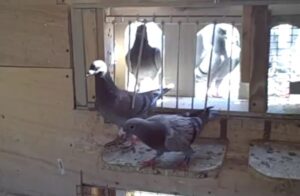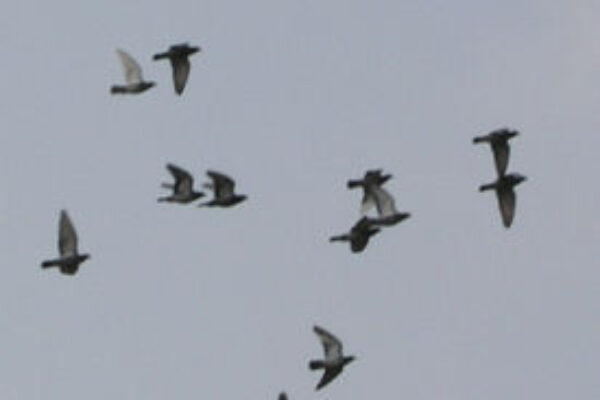“The race isn’t over until the bird is clocked.”
What is trapping and clocking?
 “Trapping” is a term that I think stemmed out of the used of the word stall trap. When a bird came home from a race it would enter the loft through a stall or hole. Once inside the hole, the bird was trapped until the fancier could catch the pigeon and remove a countermark which was used to clock a bird. When the countermark was put inside a capsule a lever of the clock was pushed and a cylinder inside the clock would turn and seal the countermark inside the clock. At the same time, the clock would stamp on a roll of paper the day, hour, minute and second. This was then used as the official time the bird finished the race. Trapping is still the term used by most fanciers to designate or describe when a bird entered the loft. If a bird comes home, but perches on the roof of the loft and does not enter, he has not trapped. With the addition of electronic computer clocks, scanners and microchip bands birds do not need to be caught or trapped in order to be clocked. They do however, if one follows official race rules have to enter the loft or trap to be clocked.
“Trapping” is a term that I think stemmed out of the used of the word stall trap. When a bird came home from a race it would enter the loft through a stall or hole. Once inside the hole, the bird was trapped until the fancier could catch the pigeon and remove a countermark which was used to clock a bird. When the countermark was put inside a capsule a lever of the clock was pushed and a cylinder inside the clock would turn and seal the countermark inside the clock. At the same time, the clock would stamp on a roll of paper the day, hour, minute and second. This was then used as the official time the bird finished the race. Trapping is still the term used by most fanciers to designate or describe when a bird entered the loft. If a bird comes home, but perches on the roof of the loft and does not enter, he has not trapped. With the addition of electronic computer clocks, scanners and microchip bands birds do not need to be caught or trapped in order to be clocked. They do however, if one follows official race rules have to enter the loft or trap to be clocked.
Trapping, the good the bad and the down right ugly
When a bird returns home, he must enter the loft. Every fancier has experienced a time when a bird comes home, in what appears to be good race time and it either sits on the roof with no interest of trapping or goes back into the air and does victory laps. The fancier is on pins and needles or ready to pull his hair out if he thinks the bird has made good time. It’s the most frustrating time to be a fancier, other then when everyone has made good time and you have not seen a bird. Good trapping relies a lot on good training. When you feed your birds and use a sound device to “call” them in, you are training them to trap on race day. When a bird lands on the roof and hesitates to enter, giving the “call” usually jogs his memory and gets the bird to trap quickly. Sometimes a bird comes home and it appears they are “spooky” or nervous and flighty. You “call” to them repeatedly and they don’t respond, or they go back into the air. When that happens, it’s best to back away from the loft and watch at a distance until the bird calms down and enters the loft. On a hard race though, from my experience, the birds often trap without a problem. Also, when give the “call” it appears to me the birds pick up their pace and hurry into the loft. In pigeon racing, seconds matter greatly. In some races, seconds can be the difference between 1st and 50th place.
Trap Shyness
This mostly applies to birds that are manually clocked. When a bird learns from experience that when he enters the loft he is going to be caught immediately, it can cause trap shyness. The bird hesitates to enter the loft. All the “calling” in the world will cause additional hesitation as “the call” indicates to the bird that this surely will happen upon his entrance to the loft. I do not know any way to cure trap shyness once a bird develops it. For electronic clock users, who instead of catching their pigeon but instead just look at the clock display the birds do not seem to get trap shyness. It’s fantastic as you are looking at the display and your poor bird which just flew 100’s of miles is getting a fresh cold drink, maybe eating some feed left for him, or excitingly going to his nest box and greeting his mate whom he flew home to. An electronic clock is an advantage regarding trap shyness.
Electronic Computer Clock versus Manual Clock
Other than trap shyness, what is the difference between a manual clock and an electronic computer clock? When does it really matter. For a manual clock, you must catch your bird and remove the countermark for the bird to officially be clocked. You will loose seconds between when the bird enters the loft and when he is clocked. If you are not present or aware your bird has entered the loft, you may not be aware to clock him and you will lose major time. With the electronic computer clock you do not even need to be home to clock your birds. For some who work shift work and odd days off, this development was a god send. The disadvantage of not being home is that if your birds hesitate on the loft, you are not present to give “the call” to hurry them inside. Now assuming two fanciers, one with a manual clock and one with an electronic computer clock are both home, who has the advantage? If a small group arrives the manual clock owner has to catch each individual pigeon and clock them, there will most likely be seconds between each bird’s time. The owner of the electronic computer clock will watch the small group enter the loft and know that they will all be clocked together within a matter of seconds. The electronic computer clock owner has the advantage. For a long race, both owners most likely have no difference. The birds will not arrive as a small group and a few seconds will not have a huge difference on the results as on longer races, the difference between the winners and 2nd place are often minutes instead of seconds.
pigeon racing, racing pigeon, racing pigeons, race pigeon, race pigeons, racing homer, racing homers, pigeons racing, pigeon, pigeons, homing pigeons, homing pigeon, pigeons for sale, pigeon auction, pigeon forum, pigeon racing pigeon, pigeon racing pigeons









qam mom
THERE IS VEARING TEMPERATURE IN MY REGION IF WE START RACE FROM SOUTH IT IS ABSOLUTELY DIFFERENT TEMPERATURE AT THE RELEASE TIME i,e TOWARDS WARMER AND OF START RACE FROM NORTH REGION IT IS COLDER, NOW THE QUESTION IS WHAT TO DO WITH SUCH SITUATION TO PUT THE PIGEON AT COMFORT
time in the loft with the birds gives them comfort if they no you they will come to you when you call them .video on my site glemserloft.com
The only thing I would add is on short races I reduce their feed by one half the day of basketing. Being a little hungry gives them an additional incentive to trap a little faster. Good article.
I have a big tree right behind my loft,& sometimes they hang up in it! Thanks for a few more tips!